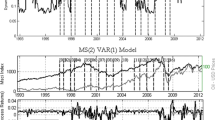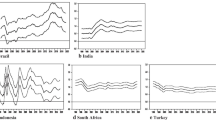Abstract
We examine the impact of oil price shocks on stock market returns in Saudi Arabia using the country-level as well as the industry-level stock market data. We find that the relation between changes in oil prices and equity returns is positive and significant at the country-level and at the industry level. Our results show that oil prices have asymmetric effects on equity returns for 4 out of 15 industrial sectors (e.g., hotel and tourism, insurance, multi-investment, and petrochemicals). These results have significant implications for investors, portfolio managers, policymakers, and corporate finance managers.

Similar content being viewed by others
Notes
According to British Petroleum data at the end of 2009, Saudi Arabia is the world’s largest oil producer with approximately 19.8 percent of total world’s reserve.
On May 25, 1981, six countries of the Arab Gulf region (Bahrain, Kuwait, Oman, Qatar, Saudi Arabia, and the United Arab Emirates) ratified the charter that established the Cooperation Council for the Arab States of the Gulf, known as Gulf Cooperation Council (GCC) countries hereafter.
For example, Bahrain is less reliant on oil than Saudi Arabia.
Individual country’s efforts to diversify and liberalize the economy differ across GCC countries. For example, Saudi Arabian state-controlled companies also dominate the listing. The stock market capitalization of Saudi Arabia typically concentrates on banking, insurance, and service industries. These elements are likely to undermine normal market operations such as arbitrage and speculation in the Saudi stock market.
References
Aggarwal R, Akhibe A, Mohanty S (2012) Oil price shocks and transportation firm asset prices. Energy Econ 34(5):1370–1379
Aleisa E, Dibooglu S, Hammoudeh D (2004) Relationships among U.S. oil prices and oil industry equity indices. Int Rev Econ Finance 13(4):427–453
Al-Mudhaf A, Goodwin T (1993) Oil shocks and oil stocks: evidence from the 1970s. Appl Econ 25(2):181–190
Arouri MEH (2011) Does crude oil move stock market in Europe? A sector investigation. Econ Model 28(4):1716–1725
Arouri MEH, Nguyen D (2010) Oil prices, stock markets, and portfolio investment: evidence from sector analysis in Europe over the last decade. Energy Policy 38(8):4528–4539
Arouri MEH, Rault C (2012) Oil prices and stock markets in GCC countries: empirical evidence from panel analysis. Int J Finance Econ 17(3):242–253
Asteriou D, Bashmakova Y (2013) Assessing the impact of oil returns on emerging stock markets: a panel data approach for ten Central and Eastern European Countries. Energy Econ 38:204–211
Ball L, Mankiw G (1994) Asymmetric price adjustment and economic fluctuations. Econ J 104(423):247–261
Barsky RB, Kilian L (2004) Oil and macroeconomy since the 1970s. J Econ Perspect 18(4):115–134
Basher SA, Sadorsky P (2006) Oil price risk and emerging stock markets. Global Finance J 17(2):224–251
Bernanke B (1983) Nonmonetary effects of the financial crisis in the propagation of the great depression. Am Econ Rev 73(3):257–276
Bhar R, Nikolova B (2009) Oil prices and equity returns in the BRIC countries. World Econ 32(7):1036–1054
Bjørnland HC (2009) Oil price shocks and stock market booms in an oil-exporting country. Scott J Polit Econ 56(2):232–254
Borenstein S, Cameron AC, Gilbert R (1997) Do gasoline prices respond symmetrically to crude oil price changes? Q J Econ 112:305–339
Boyer M, Filion D (2007) Common and fundamental factors in stock returns of Canadian oil and gas companies. Energy Econ 29(3):428–453
Broadstock D, Filis G (2014) Oil price shocks and stock market returns: new evidence from United states and China. Int Financ Mark Inst Money 33:417–433
Chen NF, Roll R, Ross SA (1986) Economic forces and the stock market. J Bus 59(3):383–403
Cheung Y, Ng L (1998) International evidence on stock market and aggregate economic activity. J Empir Finance 5(3):281–296
Cologni A, Manera M (2013) Exogenous oil shocks, fiscal policies and sector reallocation in oil producing countries. Energy Econ 35:42–57
Cong RG, Wei YM, Jiao JL, Fan Y (2008) Relationships between oil price shocks and stock market: an empirical analysis from China. Energy Policy 36(9):3544–3553
Cunado J, Perez de Garcia F (2005) Oil prices, economic activity and inflation: evidence for some Asian countries. Q Rev Econ Finance 45(1):65–83
Davis S (1987) Allocative disturbances and specific capital in real business cycles theories. Am Econ Rev 77(2):326–332
Degiannakis S, Filis G, Floros C (2013) Oil and stock returns: evidence from European industrial sector indices in a time-varying environment. Int Financ Mark Inst Money 26:175–191
Driesprong G, Jacobsen B, Maat B (2008) Striking oil: Another puzzle? J Financ Econ 89(2):307–327
Elder J, Serletis A (2010) Oil price uncertainty. Jo Money Credit Bank 42(6):1137–1159
El-Sharif I, Brown D, Burton B, Nixon B, Russell A (2005) Evidence on the nature and extent of the relationship between oil prices and equity values in the UK. Energy Econ 27(6):819–830
Elyasiani E, Mansur I, Odusami B (2011) Oil price shocks and industry stock returns. Energy Econ 33(5):966–974
Faff R, Brailsford T (1999) Oil price risk and the Australian stock market. J Energy Finance Dev 4(1):69–87
Fama E (1990) Stock returns, expected returns, and real activity. J Finance 45(4):1089–1108
Ferderer J (1996) Oil price volatility and the macroeconomy: a solution to the asymmetry puzzle. J Macroecon 18(1):1–16
Filis G (2010) Macro economy, stock market and oil prices: Do meaningful relationships exist among their cyclical fluctuations? Energy Econ 32(4):877–888
Filis G, Chatziantoniou I (2014) Financial and monetary policy responses to oil price shocks: evidence form oil-importing and oil-exporting countries. Rev Quant Finance Account 42:709–729
Frey G, Manera M (2007) Econometric models of asymmetric price transmission. J Econ Surv 21(2):349–415
Gogineni S (2010) Oil and the stock market: an industry level analysis. Financ Rev 45(2):995–1010
Hamilton JD (1983) Oil and macroeconomy since World War II. J Polit Econ 91(2):228–248
Hamilton JD (1996) This is what happened to the oil price-macroeconomy relationship. J Monetary Econ 38(2):215–220
Hamilton JD (2003) What is an oil shock? J Econom 113(2):363–398
Hamilton JD, Herrera AM (2004) Oil shocks and aggregate macroeconomic behavior: the role of monetary policy. J Money Credit Bank 36(2):751–782
Hammoudeh S, Aleisa E (2004) Dynamic relationship among GCC stock markets and NYMEX oil futures. Contemp Econ Policy 22(2):250–269
Hammoudeh S, Li H (2005) Oil sensitivity and systematic risk in oil-sensitive stock indices. J Econ Bus 57(1):1–21
Huang R, Masulis R, Stoll H (1996) Energy, shocks and financial market. J Futures Mark 16(1):1–27
Jones C, Kaul G (1996) Oil and the stock markets. J Finance 51(2):463–491
Kilian L (2008a) The economic effects of energy price shocks. J Econ Lit 46(4):871–1009
Kilian L (2008b) Exogenous oil supply shocks: How big are they and how much do they matter for the U.S. economy? Rev Econ Stat 90(2):216–240
Kilian L (2009) Not all oil price shocks are alike: disentangling demand and supply shocks in the crude oil market. Am Econ Rev 99(3):1053–1069
Kilian L, Park C (2009) The impact of oil prices shocks and the U.S. stock market. Int Econ Rev 50(4):1267–1287
Lee K, Ni S (2002) On the dynamic effects of oil price shocks: a study using industry level data. J Monetary Econ 49(4):823–852
Lee K, Ni S, Ratti RA (1995) Oil shocks and the macroeconomy: the role of price variability. Energy J 16(4):9–56
Lilien D (1982) Sectoral shifts and cyclical unemployment. J Polit Econ 90(4):777–794
Miller U, Ratti R (2009) Crude oil and stock markets: stability, instability, and bubbles. Energy Econ 31(4):559–568
Mimouni K, Charfeddine L, Al-Azzam M (2016) Do oil producing countries offer international diversification benefits? Evidence from GCC countries. Econ Model 57:263–280
Mohanty S, Nandha M (2011a) On oil risk exposure: the case of the U.S. oil and gas sector. Financ Rev 46(1):165–191
Mohanty S, Nandha M (2011b) Oil shocks and equity returns: an empirical analysis of the US transportation sector. Rev Pac Basin Financ Mark Policies 14(1):101–128
Mohanty S, Nandha M, Turkistani A, Aliatani M (2011) Oil price movements and stock market returns: evidence from Gulf Cooperation Council (GCC) countries. Global Finance J 22(1):42–55
Mohanty S, Akhigbe A, Al-Khyal T, Bugshan T (2013) Oil and stock market activity when prices go up and down: the case of the oil and gas industry. Rev Quant Finance Account 41(2):253–272
Mork KA (1989) Oil and the macroeconomy when prices go up and down: an extension of Hamilton’s results. J Polit Econ 97(3):740–744
Mork KA (1994) Business cycles and the oil market. Energy J 15:15–38
Nandha M, Brooks R (2009) Oil prices and transport sector returns: an international analysis. Rev Quant Finance Account 33(4):393–409
Nandha M, Faff R (2008) Does oil move equity prices? A global view. Energy Econ 30(3):986–997
Narayan P, Sharma S (2011) New evidence on oil price and firm returns. J Bank Finance 35(12):3253–3262
Park J, Ratti RA (2008) Oil price shocks and stock markets in the U.S. and 13 European countries. Energy Econ 30(5):2587–2608
Peltzman S (2000) Prices rise faster than they fall. J Polit Econ 108(3):466–502
Pindyck RS (1991) The present value model of rational commodity pricing. Working paper, Massachusetts Institute of Technology (MIT), Sloan School of Management 3354–3391
Ramady MA (2010) The Saudi Arabian economy: policies, achievements and challenges, 2nd edn. Springer, New York
Sadorsky P (1999) Oil price shocks and stock market activity. Energy Econ 21(5):449–469
Sadorsky P (2001) Risk factors in stock returns of Canadian oil and gas companies. Energy Econ 23(1):17–28
Sadorsky P (2006) Modelling and forecasting petroleum futures volatility. Energy Econ 28(4):467–488
Schwert G (1990) Stock returns and real activity: a century of evidence. J Finance 45(4):1237–1257
Wang Y, Wu C, Yang L (2013) Oil price shocks and stock market activities: evidence from oil importing and oil exporting countries. J Comp Econ 41(4):1220–1239
Wei C (2003) Energy, the stock market, and the putty-clay investment model. Am Econ Rev 93(1):311–323
Zellner A (1962) An efficient method of estimating seemingly unrelated regression (SUR) equations and tests of aggregation bias. J Am Stat Assoc 57(298):500–509
Acknowledgements
We thank Michel Habib and two anonymous referees for helpful comments and suggestions. We gratefully acknowledge the research support from Baruch College, and Brooklyn College of City University of New York. We are thankful to Mr. Jafar Awad Ahmed (Advisor, Market Statistics and Indexes at the Saudi Stock Exchange, Tadawul) for providing us with valuable information related to the Saudi Stock Market. We thank seminar participants at the 2012 World Finance Conference on an earlier version of our paper.
Author information
Authors and Affiliations
Corresponding author
Rights and permissions
About this article
Cite this article
Mohanty, S.K., Onochie, J. & Alshehri, A.F. Asymmetric effects of oil shocks on stock market returns in Saudi Arabia: evidence from industry level analysis. Rev Quant Finan Acc 51, 595–619 (2018). https://doi.org/10.1007/s11156-017-0682-5
Published:
Issue Date:
DOI: https://doi.org/10.1007/s11156-017-0682-5




